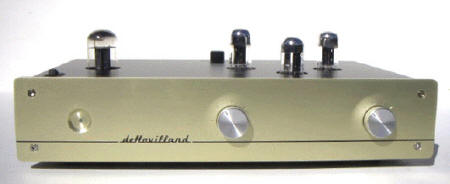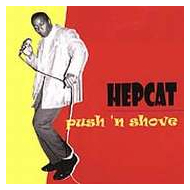You are reading the older HTML site
Positive Feedback ISSUE
18
march/april 2005
deHavilland
UltraVerve preamplifier
as reviewed by Francisco Duran

|
FRANCISCO DURAN'S SYSTEM: LOUDSPEAKERS ELECTRONICS SOURCE CABLES ACCESSORIES
|
I have to stop trying out gear that is on its way back to the manufacturer after review. This time I mean it, really! First I tried two pairs of Mobile Fidelity speakers, and now the deHavilland UltraVerve preamplifier has made its way into my system. Add to this the fact that our esteemed editor, David Robinson, blessed the UltraVerve back in Issue 12, saying it had juice and jump, and Roger Gordon provided further thoughts in Issue 15. Also add the fact that this unit has four beautiful NOS glass bottles popping out of its bonnet, and a listen was unavoidable.
An email to George Kielczynski, letting him know that his preamplifier was ready to go back to the deHavilland plantation, garnered some valuable new information about the unit. The sample on hand had not benefited from an upgrade that consisted of bypassing some Russian-made capacitors with hot little parts called Auricaps. Since the upgrade didn't involve a lot of electrical or mechanical surgery, we agreed that it could be done right here, saving the freight charges and grief of a ride back and forth to deHavilland. They are still in the state, but it's a big state! The grief part comes from shipping by UPS or FedEx. Why ship even tubes around the block when you don't have to?
The capacitor bypass can be done by anyone with a modicum of soldering experience, which left out yours truly, especially after I looked at the spot in which the bypass caps had to be installed. It was not a difficult installation, but it was tricky. At this point, I would like to both introduce and thank Mr. Jay Cox, a fine electrical engineer and designer, and father to fellow PFO writer Larry Cox. He knows his way around a soldering gun as much as Obi-Wan Kenobi knows how to wield a light saber, and he did a very clean installation of the new capacitors.
In my experience, new capacitors need plenty of time to break in. This is no place for impatient reviewers, but I can guess what some of you are thinking: After all the time listening to the preamplifier break in, how could I remember how the unit originally sounded? Good question. Without the luxury of having two identical, broken-in units, one modified, the other not, all I could do was refamiliarize myself with the preamplifier. If the upgrade was worthwhile, I'd know it.
Well, juice and jump it had, and let's add jive for good measure! Inserting the UltraVerve into my system gave it a shot in the arm. It had dynamics and bass that my resident Canary preamplifier or my other treasure, the Reference Line passive, couldn't match. The UltraVerve and its octal tubes really went to work, putting those wimpy 9-pin 6922s in my Canary preamplifier to shame in the dynamics department. Spinning Black Uhuru's Mystical Truth CD showed that this preamplifier could boogie. The bass (played by five different musicians on this CD), sounded strong, yet integrated with the rest of the music. On Bebel Gilberto's CD, Tanto Tempo, the UltraVerve showed that there is more to bass than dynamic slam. The subtle finger picking of Jorge Helder on the song "Bananeira" sounded natural and articulate, yet his bass notes also sounded dimensional and full-bodied, with real space around them. There was a natural weight to the sound of the notes that was not unlike the sound of a live upright bass.
This led me to wander into the wide and deep soundstage that the UltraVerve mustered with ease. It was downright explosive compared to my passive preamplifier. The spatial properties of the recording venue were easily heard, but never exaggerated. Dipping into some Crosby and Nash (something I do from time to time) revealed some surprises compared to my resident preamps. On the song "Mama Lion," from Crosby and Nash's Wind on the Water CD, I heard similar bass properties, and the UltraVerve did a respectable job of separating Crosby and Nash's voices and the lead guitar during the dynamic peaks of this song. Then I listened to the Jayhawks, and their guitars and voices sounded spacious, clean, and extended. The preamplifier had a very refined treble that was not sweet or rolled off, and never etched, bright, or flat. The UltraVerve reproduces the timbre and harmonics of music in a natural way. It never goes into lush, romantic territory, yet never denies its tube pedigree, choosing instead to walk the fine line between the worlds of solid state and tube. It is fast, clean, and dynamic while retaining that sweet, dimensional tube sound. This preamplifier seems to do it all.
Despite all of the positive attributes I have mentioned, no component is perfect, and the original UltraVerve had a little stiffness and mechanical hi-fi-ness. This is where the Auricaps came in, and they went a long way toward diminishing these artifacts. For instance, after the upgrade and break-in period, I played the Jayhawks again, and noticed that the guitars twanged just that much more naturally. On a Santana CD, cymbals, bells, chimes, and cow bells resonated just a bit more, and floated a bit more effortlessly in the air. Musicians sounded less stiff and more in the groove. There is no need to stiffen Ray Brown, now, is there? As laidback as Willie is, why make him uptight? Jump, juice, and jive is great for toe tapping, but too much caffeine is not good either.
The Auricap upgrade strips away a slight electronic sound, along with a little stiffness. It gives the UltraVerve a more organic, musical wholeness. It is a very good-sounding preamplifier to begin with, and the modification brought it closer to allowing me to forget about electronics and enjoy the music. I would much rather have a manufacturer contact me with news of a parts upgrade than have the unit become obsolete six months after I buy it.
Comparing the UltraVerve to my Canary CA-601MkII was
interesting. The first thing I noticed with the Cary was that the bass had less
impact. Although the Canary has
 good dynamics, the lowest bass was not in the
same league. The Canary also sounded smoother, and its transients were diffuse.
It is very clean, with no grain, glare, or brightness, but there is a slight
smoothness to the sound that borders on being a coloration. The UltraVerve loses
the halo of smoothness in favor of a clear, clean sound, along with a seductive,
dimensional sweetness. I only needed to spin a few discs to get back into that
UltraVerve groove. The UV hooked up to my Margules U280SC amplifier in triode
mode was something special. Spinning Hepcat's 1993 release, Out of Nowhere and
their Push "N Shove CD revealed so much detail that it felt like I was hearing
them live in the studio. I did not hear the etched, relentless detail of some
audiophile products but the subtle shifts in dynamics and the tiny imaging and
staging cues that you hear in live music. I kept saying to myself, "Wow, so much
detail, but it is warm and clean." All of these previously unnoticed details
sprang up in a natural and coherent way, proving that there is still hope for
jaded reviewers.
good dynamics, the lowest bass was not in the
same league. The Canary also sounded smoother, and its transients were diffuse.
It is very clean, with no grain, glare, or brightness, but there is a slight
smoothness to the sound that borders on being a coloration. The UltraVerve loses
the halo of smoothness in favor of a clear, clean sound, along with a seductive,
dimensional sweetness. I only needed to spin a few discs to get back into that
UltraVerve groove. The UV hooked up to my Margules U280SC amplifier in triode
mode was something special. Spinning Hepcat's 1993 release, Out of Nowhere and
their Push "N Shove CD revealed so much detail that it felt like I was hearing
them live in the studio. I did not hear the etched, relentless detail of some
audiophile products but the subtle shifts in dynamics and the tiny imaging and
staging cues that you hear in live music. I kept saying to myself, "Wow, so much
detail, but it is warm and clean." All of these previously unnoticed details
sprang up in a natural and coherent way, proving that there is still hope for
jaded reviewers.
I have owned other preamplifiers that offered upgrades at a substantial price increase in priceómy long-gone Audio Research SP-9 comes to mind. My Classe CP-60 changed models almost once a year. Admittedly, the CP-60 had quite a long lifespan, but I appreciate a company that gets its designs right in the first place. As time goes by, and new parts are made available to the designers, small but significant upgrades can be made while still keeping the cost down for the customer. This appeals to me, and I have upgraded almost all of my components in this way. The deHavilland UltraVerve is definitely not in the component-of-the-month club.
I liked the UltraVerve preamplifier, and I really liked the upgraded unit. It is detailed but musical. The Auricap upgrade is a very worthwhile move in the direction of music for minimal cost. Francisco Duran
UltraVerve preamplifier
Retail: $2495
deHavilland Electric Amplifier Company
108 Wallace Lane
Cloverdale, CA 95425
TEL: 707. 894. 0176
web address: www.dehavillandhifi.com
